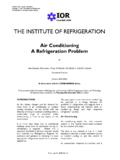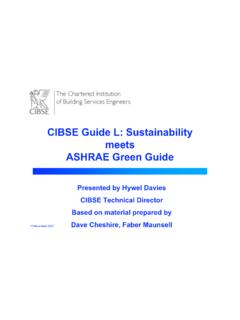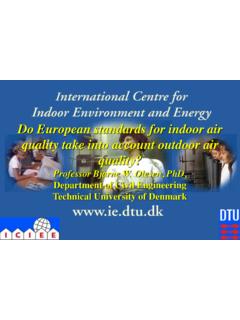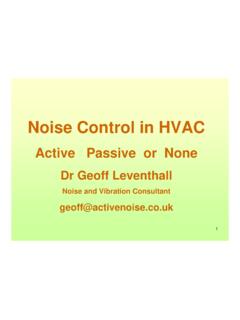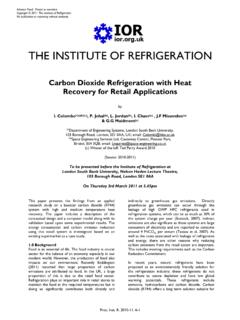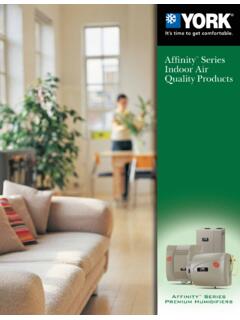Transcription of Relative Humidity - CIBSE
1 %rh Why, What & How Dr. Jeremy Wingate Rotronic Instruments (UK) Ltd Wednesday, 14th January 2015 CIBSE Webinar Rotronic Instruments Sales, training and consultancy role Forest Research Regenerating brownfield land through novel decontamination technologies C-Cure Solutions Ltd Joint founder of spin-out aimed at commercialising charcoal technologies PhD from Surrey University Decontamination of mining sites by novel charcoals 1. Human Comfort Sweating = evaporation %rh makes you feel colder Human comfort Temperature Radiated and Air Humidity Air velocity 2. Human Health Dust Mites 50%rh is fatal %rh is worst Pathogen Survival in Air 40-60%rh most lethal for viruses %rh is worst (winter). Mould %rh & poor ventilation 3. Conservation Condensation Mould & Rot Condensing on windows Heritage & Storage Museum artefacts Records Reliability Maintaining equipment etc 4.
2 Energy & Efficiency Building Control Better measurements Intelligent control Sensitive products Process Control Save time and money Ensure consistent product Regulation Ever increasing . 1. States of Matter Solid - Definite shape and volume Particles are closely packed and only vibrate 2. States of Matter Liquid - Definite volume Particles flow to take shape of container 3. States of Matter Gas (Water Vapour). - Neither volume or shape Particles will expand to fill a space 4. Dalton's Law of Partial Pressures In a gas mixture such as room air the total pressure can be expressed as . P(water) = vapour pressure 5. Composition of Air Components of air (all in gas form). % water vapour (by volume). 6. Composition of Air 0%rh ~12%rh ~35%rh ~95%rh (air at ~30 C). What about %rh? 7. Recap! Water (H2O) in the gas phase is called VAPOUR. Water vapour is transparent The amount of gas can be stated as a partial pressure Air typically holds ~1 - 4 % water vapour (10 - 40 mbar).
3 AIR CAN ONLY HOLD A LIMITED AMOUNT OF WATER. VAPOUR! 8. Last but not least Hotter air can support more water vapour When air can hold no more water it is SATURATED. The partial pressure at this exact point is called the SATURATION VAPOUR PRESSURE. 9. Psychrometric Charts Vapour Pressure (mBar). 10. Psychrometric Charts Vapour Pressure (mBar). 11. So Relative Humidity The ratio of actual water vapour pressure against the saturation vapour pressure (in %).. how much water vapour is in the air compared to how much water vapour there could be in the air 12. Effect of temperature Same amount of water, different %rh 13. Other parameters Dew point The temperature to which you need to cool a gas in order for saturation (condensation) to occur Mixing ratio (absolute Humidity ). Mass of vapour per unit mass of dry gas Dimensionless ratio although g/kg is often used Wet Bulb The temperature to which a thermometer covered with a wet wick' will cool (due to evaporation ).
4 Enthalpy Of the dry air and evaporated water 1. Historic methods . Mechanical Horse Hair / Cat Gut! Poor accuracy Poor repeatability Slow response Psychrometer Measurement of wet and dry bulb temperatures Still used in chamber control Requires regular cleaning and service Not reliable for building control 2. Relative Humidity Sensors Very widely used Highly practical Based around variations in electrical properties of polymers - Resistive or Capacitive Factory adjusted to provide %rh measurements <1mm Protection filter Micro- Foil electrodes pores Dielectric polymer Connecting wires 3. Relative Humidity Sensors Pros Fast response Robust Wide operating range Low cost Cons Stability and repeatability Temperature dependence Drift Contamination effects 4. Typical Humidity Measurement Problems Temperature Effects Calibration Duct Wall Check instrument reflects the true Sensor application temperature Stabilisation time Trans- mitter Stem conduction Self heating 25 C Temperature 55 C.
5 Temperature coefficients Gradient 5. Typical Humidity Measurement Problems Pressure Effects Does not effect %rh Some parameters are (eg. dew point). Drift ALL Humidity sensors drift over time Varies Manufacturer Filters Application Regular calibration 6. Typical Humidity Measurement Problems Contamination Particulate deposits Become part of the sensor Chemical attack Solvents Atmospheric pollution Filter maintenance Correct filters Regular replacement 7. Best Practice Notes Use quality reference instruments when commissioning with traceability to national standards Ensure good insertion and seal when measuring ducts 8. Best Practice Notes Ensure suitable stabilisation time Log 30 minutes of data True Measure until stable Stability Consider both C and %rh %rh Apparent Stability Ensure regular calibration of Time references and store carefully Loop check analogue systems for other errors 1.
6 Sensor Locations Representative location with good air movement Avoid close proximity to;. Heaters Cooling coils Steam injectors High air turbulence Install duct sensors into air flow (reduces stem conduction). Immerse sensors as much as possible 2. Sensor Locations Consider using temperature independent parameters Desired condition = 50%rh @ 23 C. = g/kg (mixing ratio). Control hum and dehum system to g/kg (independent of temp). Ensure room temp is 23 C and %rh will be as required Outside air sensors North facing wall Mounted in a weather shield Away from other heat / Humidity sources 3. A note on accuracy Always consider accuracy and drift (what is best long term?). Measuring Humidity is hard (3333x worse than temperature). UK National Standards; vs C. The very best %rh sensors claim Temperature effects can be huge (~5%rh / C error). As such close control for Humidity is not easy!
7 CIBSE Article on NPL Project Rotronic White Paper on Modern Monitoring and Control Jeremy Wingate BSc MBA PhD. 01293 843701. #rotronicuk
